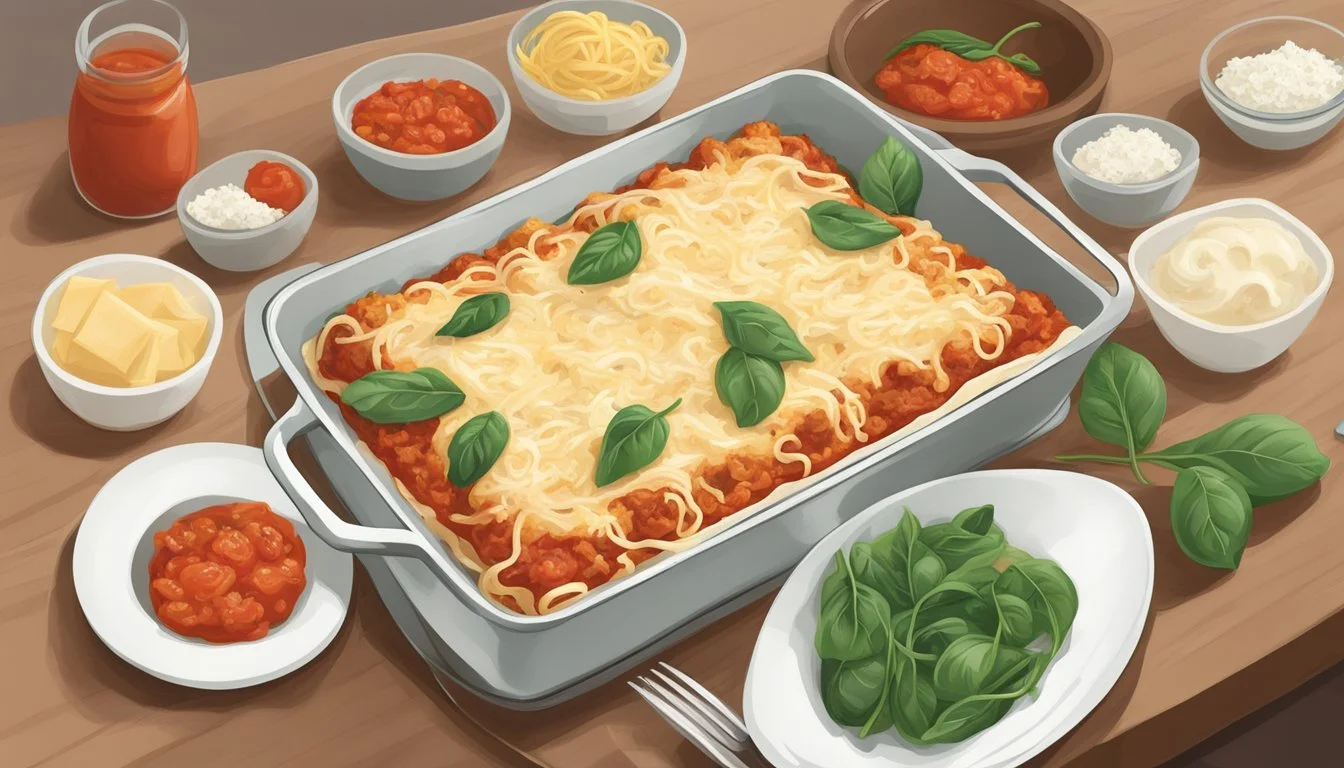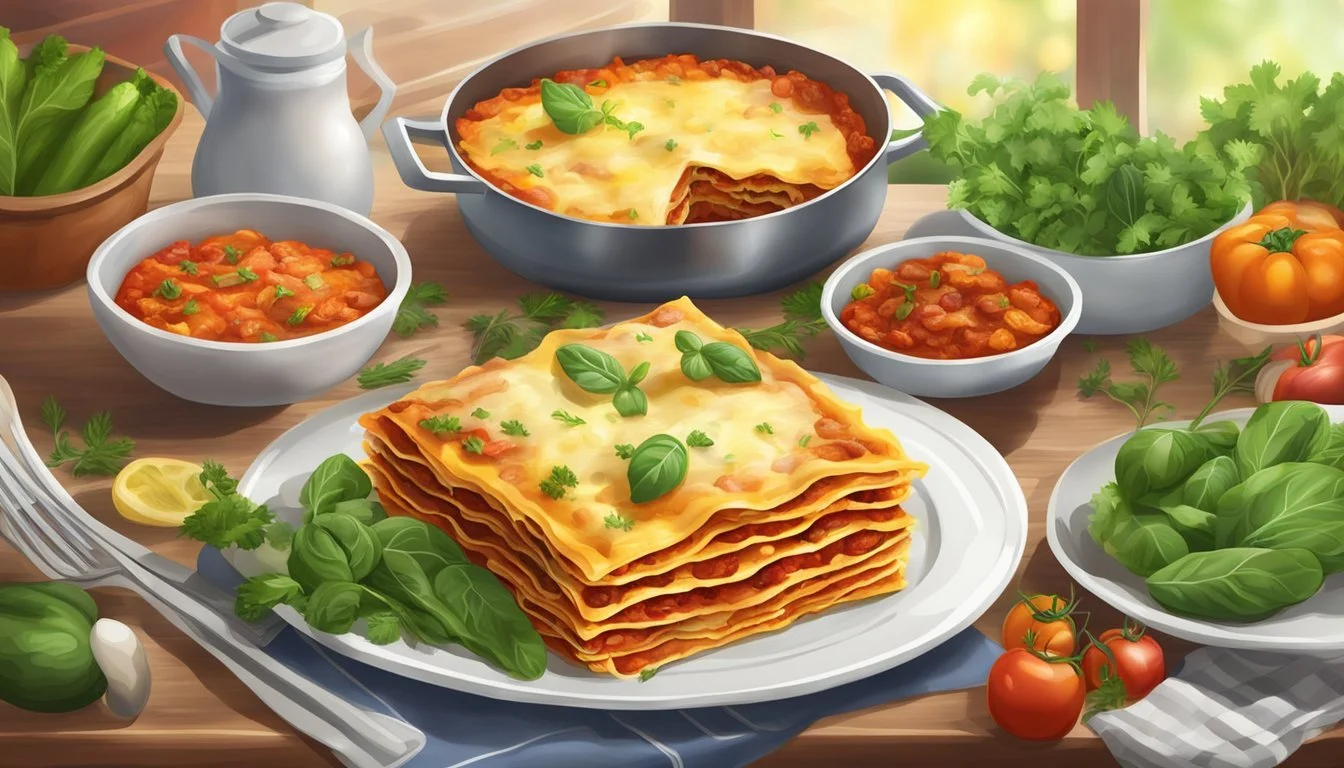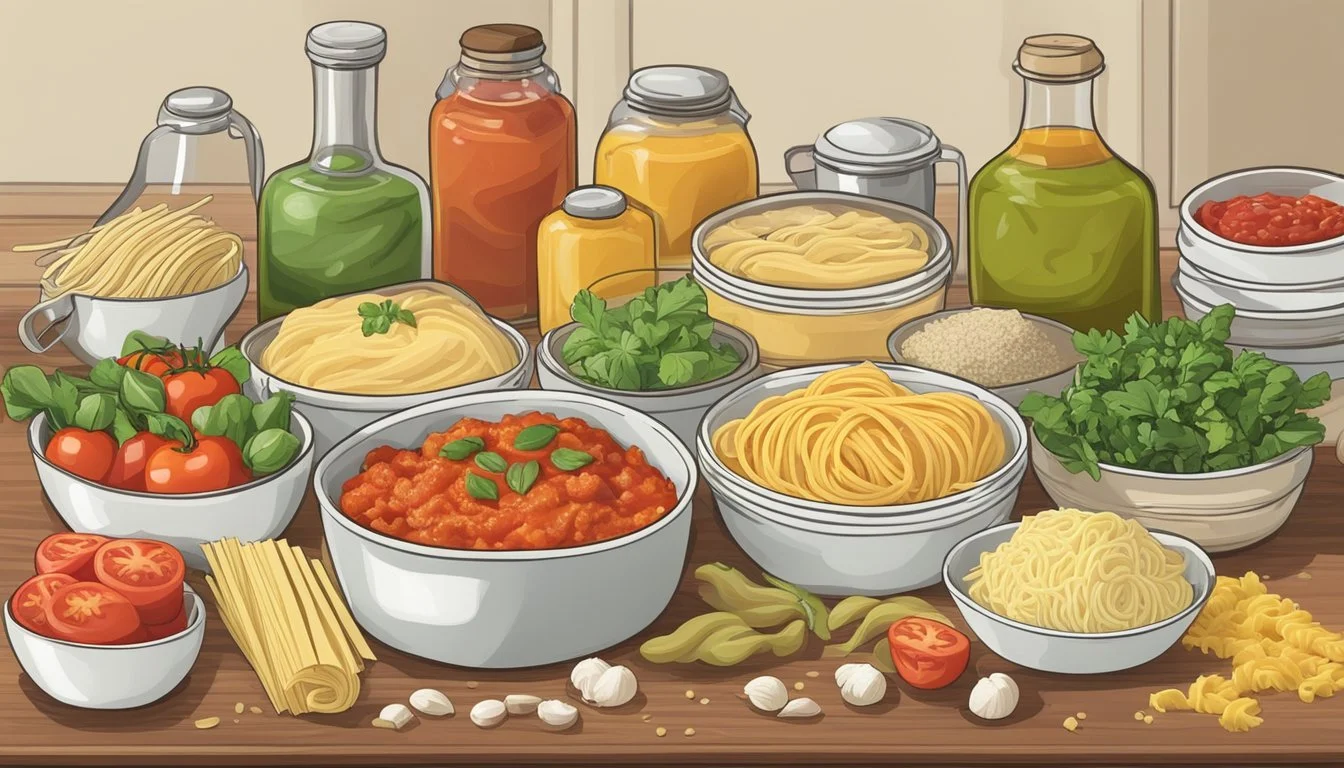Is Lasagna Gluten-Free?
Understanding Your Pasta Options
Lasagna is a classic Italian dish beloved for its layers of pasta, cheese, and rich meat sauce. Traditional lasagna is not gluten-free, as it is typically made with wheat-based noodles that contain gluten, a protein found in wheat, barley, and rye that can cause health issues for individuals with celiac disease or gluten sensitivity. However, the rise in awareness of gluten-related disorders has led to a surge in gluten-free alternatives, which include lasagna noodles made from rice, corn, or other gluten-free grains.
The key to a successful gluten-free lasagna lies in selecting the right ingredients. Gluten-free lasagna noodles are now more readily available and come in both the classic boil-before-use variety and the more convenient oven-ready options that do not require pre-cooking. When preparing the dish, cooks must ensure that all other ingredients, such as sauces and fillings, are also free from gluten-containing elements. By paying close attention to the labels and choosing certified gluten-free products, they can create a lasagna that is safe for individuals avoiding gluten without compromising on taste.
Despite the ingredient substitutions, the essence of lasagna can still be captured with a gluten-free recipe. The layering technique remains unchanged, and by using a blend of gluten-free noodles, quality cheeses, and a flavorful meat or vegetable sauce, the dish can still provide the same comforting and hearty eating experience expected from a traditional lasagna. With these gluten-free alternatives, even those adhering to a strict gluten-free diet can enjoy the rich and satisfying flavors of this timeless comfort food.
Understanding Gluten-Free Diets
A gluten-free diet is essential for managing symptoms and health complications associated with celiac disease, gluten sensitivity, and certain other medical conditions. Gluten is a protein found in wheat, barley, rye, and triticale, and avoiding it is not just a dietary choice but a necessary adjustment for many.
When it comes to gluten-free cooking, it’s important to identify substitute ingredients that provide similar textures and flavors as their gluten-containing counterparts. For example, gluten-free dinner recipes might utilize flours made from rice, corn, almond, or coconut. These alternatives offer an array of options for anyone seeking to enjoy dishes without gluten.
Gluten-Free Lasagna can be a delightful addition to any gluten-free diet. Traditional lasagna is typically not gluten-free as it contains pasta made from wheat. However, cooks can now find gluten-free lasagna noodles made from rice or other gluten-free grains to make this classic dish accessible.
Here's an outline for crafting a gluten-free lasagna:
Noodles: Use gluten-free lasagna noodles, available in various supermarkets or health food stores.
Sauce: Opt for sauces that are labeled gluten-free, or make a homemade version ensuring all ingredients are free of gluten.
Cheese: Most cheeses are naturally gluten-free, but always check labels for additives.
Fillings: Vegetables, meats, and seasonings can be added, but verify that any processed items are free from gluten contaminants.
Preparing gluten-free meals such as lasagna often requires extra attention to labels and potential cross-contamination. By adhering to these guidelines, individuals can enjoy a diverse range of foods while maintaining a gluten-free diet.
Essential Ingredients for Gluten-Free Lasagna
Creating the perfect gluten-free lasagna requires careful selection of substitute ingredients without compromising on the traditional flavors. Ensuring each component is free from gluten is essential for a safe and delicious meal.
Choosing the Right Gluten-Free Noodles
For the foundation of any lasagna, the noodles are crucial. Gluten-free lasagna noodles come in various forms, including oven-ready options that do not require pre-cooking. These should be made from a blend of gluten-free grains like rice, corn, or quinoa flour. Check the packaging to confirm the absence of gluten.
Traditional Boil Noodles: Must be cooked before layering.
Oven-Ready Noodles: No pre-cooking necessary, saves time.
Selecting the Best Cheeses
Cheese adds creamy richness to lasagna. A combination of ricotta cheese, mozzarella, and Parmesan is standard. For a gluten-free version, ensure that any pre-grated cheeses do not contain additives with gluten.
Ricotta Cheese: Provides a creamy layer.
Shredded Mozzarella: Melts well for gooey layers.
Grated Parmesan: Offers a salty, umami flavor.
Preparation of Meats
The choice of meat adds depth to lasagna's flavor. Options like lean ground beef, ground turkey, or Italian sausage are commonly used. They must be browned in advance and ensure that any seasonings or fillings added to the meat are gluten-free.
Ground Beef or Turkey: Cook until no pink remains.
Italian Sausage: Adds a spicy kick.
Vegetables and Additional Fillings
Vegetables can provide additional texture and flavor. Common additions include onions, mushrooms, or diced tomatoes. If incorporating vegetables, cook them until they are just soft to prevent excess water from making the lasagna soggy.
Onions and Mushrooms: Sauté until tender.
Diced Tomatoes: Drain excess liquid before use.
Gluten-Free Sauces and Seasonings
The sauce binds all ingredients together. For a gluten-free lasagna, use gluten-free marinara or tomato sauce, or make your own with crushed tomatoes and tomato paste. Season with herbs like basil, oregano, and garlic but verify that they are not processed with gluten-containing items.
Sauce: Marinara, tomato sauce, or a homemade blend.
Seasonings: Fresh or dried herbs to enhance flavor—ensure they're gluten-free.
Step-By-Step Lasagna Preparation
Constructing a lasagna involves precise layering, careful timing for baking, and allowing the dish to rest before serving. This section will guide readers through the necessary steps to ensure their lasagna has the ideal texture and flavor.
Layering Techniques
The foundation of a great lasagna lies in its layering. Start with a small amount of sauce spread at the bottom of the baking pan to prevent sticking. Then, a typical order of layering involves:
First Layer
Oven-ready noodles: Cover the sauce with a single layer, no overlapping to maintain texture.
Second Layer
More sauce: Spoon over noodles, ensuring full coverage.
Cheese mixture: Ricotta or bechamel, spread evenly.
Meat: If using, layer it on top of the cheese.
Repeat: Continue layering in this order until you near the top of the pan.
Final Layer
Finish with a generous layer of sauce, shredded mozzarella, and parmesan.
Aim for three to four layers, depending on the depth of your pan.
Baking Instructions
For optimal results:
Temperature: Preheat the oven to 375 degrees F (190 degrees C).
Timing: Cover the lasagna with foil and bake for 25 minutes. Then uncover and bake for an additional 25 minutes to brown the cheese.
Cook Time: Total cook time should be around 50 minutes to 1 hour.
Baking Dish: Use a 9x13-inch baking pan, ideally, for ample space.
Baking times may vary slightly depending on the specifics of the recipe and the oven.
Resting and Serving
Allowing the lasagna to rest is crucial as it:
Sets the layers: A rest of 10-15 minutes after baking helps to solidify the structure.
Improves texture: This prevents the lasagna from becoming runny or falling apart upon cutting.
After resting, the lasagna should be:
Servable: Cut into squares, serve with a spatula or pie server.
Servings: Can typically yield 8-12 servings, depending on size.
With these steps, one's lasagna will be ready to enjoy with a beautiful layering of flavors and a perfect texture that holds together from plate to palate.
After-Cooking Tips
Once lasagna is cooked, it's important to store, reheat, and freeze it properly to maintain its taste and texture. This section provides straightforward guidance for handling leftover lasagna.
Storing Leftovers
To keep leftover lasagna fresh, they should be stored in an airtight container. It's crucial to let the lasagna cool to room temperature before placing it into the refrigerator. This reduces the risk of bacteria growth and preserves the lasagna's quality.
Reheating Techniques
When reheating, one should focus on restoring the lasagna's moistness while ensuring it’s heated through. To microwave, cover a slice with a damp paper towel and use 50% power to avoid making it too tough, then finish at full power for a thorough warm-up. In an oven, cover the leftover lasagna with foil and reheat at 350°F to prevent drying out.
Freezing and Thawing for Make-Ahead Meals
Lasagna makes an excellent make-ahead meal. To freeze, wrap individual slices in plastic wrap and then place them in a ziplock freezer bag, squeezing out as much air as possible to ward off freezer burn. It's best to thaw frozen lasagna in the refrigerator overnight before reheating. This gradual process helps maintain the lasagna's integrity.
Accompanying Gluten-Free Dishes
When pairing dishes with gluten-free lasagna, one seeks to maintain the cozy essence of comfort food while ensuring dietary needs are met. A family favorite is garlic bread, and a gluten-free variant can carry the same aromatic appeal. Gluten-free garlic bread can be crafted using gluten-free baguettes or loaves, slathered with a blend of garlic, butter, and herbs.
For an equally enticing option, guests may enjoy gluten-free breadsticks as a side. These can either be homemade using gluten-free flour mixes or found pre-made at specialty stores. These breadsticks can be seasoned with Italian spices, garlic, and parmesan, lending a satisfying crunch and flavor.
To complement the main course with a refreshing element, one may consider serving a green salad. Simple ingredients like mixed greens, cherry tomatoes, cucumber, and a light vinaigrette can cleanse the palate between bites of rich lasagne.
Lastly, various vegetable side dishes such as roasted asparagus, steamed broccoli, or a medley of sautéed bell peppers can add a nutritious and colorful addition to the meal. Not only do these vegetables provide an array of vitamins and textures, but their subtle flavors will not overshadow the lasagna's robust taste.
By selecting the right gluten-free accompaniments, the integrity of a traditional Italian dining experience is preserved, creating a welcoming table for all to enjoy.
Pro Tips for Perfect Gluten-Free Lasagna
To ensure a gluten-free lasagna that rivals any traditional version, here are pro tips one should consider:
Choose the Right Noodles: Opt for quality gluten-free lasagna noodles that hold up during cooking to prevent a mushy texture. If available, use oven-ready gluten-free noodles to skip the pre-boiling step, ensuring a firmer outcome.
Meat Sauce Consistency: It's important for the meat sauce to be hearty but not too watery, as excess liquid can lead to disintegration of the pasta layers. Simmer the sauce until it thickens to provide a stable base for your layers.
Ricotta Filling Mastery:
Whip the ricotta cheese with eggs to create a fluffy filling. This not only adds structure but also ensures the cheese doesn't ooze out when cutting.
Season the ricotta mixture well with salt and a generous amount of ground pepper for a flavor boost.
Layering Technique:
The order of layering is crucial: start with a layer of meat sauce, followed by noodles, then the ricotta mixture, and mozzarella cheese.
Use the back of a spoon or a spatula to spread the ricotta layer evenly across the noodles, which helps to maintain an even structure and distribute flavor.
Cheese Selection:
Use a mix of cheeses, combining mozzarella for the gooey texture with Parmesan for a sharper flavor note.
Rest Before Serving:
Allow the cooked lasagna to rest for 15-20 minutes before slicing. This waiting period enables the layers to set, making for cleaner cuts and better portion control.
By adhering to these tips, one can create a gluten-free lasagna that's both comfortable in its traditional warmth and impressive in its gluten-free integrity.
Substitutes and Variations
When making gluten-free lasagna, both the choice of ingredients and how they're combined can greatly affect the final dish. This section will cover protein, dairy, and flavor options that comply with gluten-free guidelines without compromising on taste or texture.
Alternative Proteins and Fillings
For a gluten-free lasagna, traditional ground beef can be substituted with ground turkey or even a vegetarian protein such as lentils. One can also consider mixing proteins or adding vegetables like spinach or zucchini to the layers for added nutrition.
Proteins: Ground turkey, lentils, vegetables
Fillings: Spinach, zucchini
Dairy-Free and Vegan Options
A traditional lasagna's ricotta and egg mixture can be replaced with dairy-free alternatives such as cottage cheese or commercial vegan cheese products. To bind the layers without eggs, one can use dairy-free bechamel or mashed vegetables for consistency.
Cheese Substitutes: Dairy-free ricotta, vegan cheese blends
Egg Alternatives: Dairy-free bechamel, mashed vegetables
Enhancing Flavor and Texture
Adding fresh or dried herbs such as basil or parsley, and using olive oil for sautéing can enhance flavor. To improve texture, ensure gluten-free noodles are cooked al dente, and for added richness, consider incorporating an egg into the cheese mixture if dietary restrictions allow.
Herbs: Fresh or dried basil, fresh or dried parsley
Fats: High-quality olive oil
Textures: Al dente noodles, egg in cheese mixture (if not vegan)
Nutritional Information and Health Benefits
Traditional lasagna is known for its rich layers of pasta, cheese, sauce, and often meat. However, it typically contains gluten due to the wheat-based noodles. For individuals with gluten intolerance or celiac disease, consuming gluten can lead to significant health concerns, including digestive issues. Fortunately, gluten-free lasagna is an alternative that allows these individuals to enjoy the comfort of lasagna without the adverse effects associated with gluten.
Gluten-free lasagna can be equally nutritious when prepared with a focus on healthy ingredients. Gluten-free noodles are made from alternative grains or legumes, such as rice, corn, or lentils, which do not trigger gluten-related responses. Here are some nutritional benefits and considerations:
Protein Content: Lasagna can be a good source of protein, especially when it includes meat or cheese. Protein is vital for body repair and muscle maintenance.
Moderation and Balance: When portion-controlled and paired with vegetables, lasagna can fit into a balanced diet. The key is moderation and choosing lean meats and low-fat cheeses when available.
Below is a concise nutritional breakdown:
Nutrient Consideration Calories Moderate caloric content; consider portion size for weight management. Protein Rich protein source; about 8-9g of protein per 100g serving. Carbohydrates Majority from gluten-free noodles and sauce; focus on complex carbs for energy.
In summary, gluten-free lasagna can offer similar comfort as traditional lasagna while providing essential nutrients. With attention to ingredients and portion sizes, it can contribute to a healthful diet.
Conclusion
Lasagna is traditionally not gluten-free due to the wheat-based pasta used in its preparation. However, for those adhering to a gluten-free diet, there is good news. Gluten-free lasagna is achievable by substituting regular noodles with gluten-free options available in the market.
When making this comfort food, it's essential to ensure that all ingredients, including sauces and fillings, are free of gluten. Cross-contamination should also be avoided during the cooking process to ensure the meal is safe for individuals with celiac disease or gluten sensitivity.
For families looking to maintain the cherished flavors of their family favorite dish while accommodating dietary restrictions, gluten-free lasagna uses ingredients like gluten-free pasta sheets and carefully selected fillings. This allows everyone to gather around the table and enjoy a meal together without concern.
Here is a quick checklist for preparing gluten-free lasagna:
Pasta: Use gluten-free lasagna noodles.
Sauce: Check the labels for gluten-free certification.
Cheese: Choose natural cheeses which typically do not contain gluten.
Meat: If adding meat, ensure it is not processed or marinated in a gluten-containing substance.
Assembly: Cook in a clean environment to avoid cross-contamination.
The mastery of gluten-free lasagna lies in selecting quality gluten-free ingredients and meticulous prevention of cross-contamination, thus retaining the dish’s beloved taste and texture.









